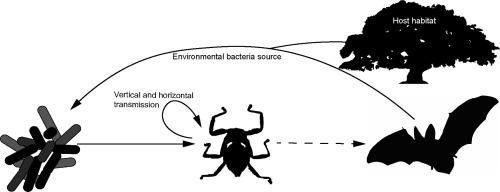当前位置:
X-MOL 学术
›
Biol. Conserv.
›
论文详情
Our official English website, www.x-mol.net, welcomes your feedback! (Note: you will need to create a separate account there.)
Microbiomes are integral to conservation of parasitic arthropods
Biological Conservation ( IF 5.9 ) Pub Date : 2020-10-01 , DOI: 10.1016/j.biocon.2020.108695 Kelly A. Speer , Nolwenn M. Dheilly , Susan L. Perkins
Biological Conservation ( IF 5.9 ) Pub Date : 2020-10-01 , DOI: 10.1016/j.biocon.2020.108695 Kelly A. Speer , Nolwenn M. Dheilly , Susan L. Perkins

|
Abstract Parasitic arthropods have not typically been included in conservation and management strategies, possibly because the most well-known blood-feeding arthropods are associated with human and livestock disease. However, the vast majority of parasitic arthropods pose no threat to human health and instead contribute to the overall stability of communities to which they belong. The loss of parasitic arthropod biodiversity likely has repercussions for host health, population density, and community structure. The need for parasitic arthropod conservation is urgent given they represent the majority of parasitic animal biodiversity and environmental change is expected to pose a significant threat to their survival. We urge that microbial associations of host–parasitic arthropod assemblages be considered in conservation efforts. Parasitic arthropods are dependent on their microbial associates for development, nutrient acquisition, immune function, and reproduction. The microbiome also mediates the interactions between a parasitic arthropod and a host, and the role of a parasitic arthropod in vectoring pathogens to its host. The microbiome may therefore represent a “weak link” that increases the susceptibility of parasitic arthropods to environmental change. Fundamental knowledge is missing, precluding assessment of this complex association between microbes and parasitic arthropods. We highlight broad areas of future research that focus on building primary knowledge, developing experimental protocols and novel statistics, and leveraging new techniques to increase the resolution at which we can examine microbial communities of parasites. Conservation of parasitic arthropods that accounts for microbiota will likely be more effective at maintaining parasite biodiversity and at controlling arthropod-vectored disease emergence.
中文翻译:

微生物组是保护寄生节肢动物不可或缺的一部分
摘要 寄生节肢动物通常不包括在保护和管理策略中,这可能是因为最著名的吸血节肢动物与人类和牲畜疾病有关。然而,绝大多数寄生节肢动物不会对人类健康构成威胁,而是有助于它们所属社区的整体稳定。寄生节肢动物生物多样性的丧失可能会对宿主健康、人口密度和群落结构产生影响。鉴于寄生节肢动物占寄生动物生物多样性的大部分,并且环境变化预计将对它们的生存构成重大威胁,因此迫切需要保护寄生节肢动物。我们敦促在保护工作中考虑宿主 - 寄生节肢动物组合的微生物关联。寄生节肢动物的发育、营养获取、免疫功能和繁殖依赖于它们的微生物伙伴。微生物组还介导寄生节肢动物和宿主之间的相互作用,以及寄生节肢动物在将病原体传播给宿主中的作用。因此,微生物组可能代表了一个“薄弱环节”,它增加了寄生节肢动物对环境变化的敏感性。缺少基本知识,无法评估微生物与寄生节肢动物之间的这种复杂关联。我们强调了未来研究的广泛领域,重点是建立初级知识、开发实验方案和新的统计数据,并利用新技术来提高我们可以检查寄生虫微生物群落的分辨率。
更新日期:2020-10-01
中文翻译:

微生物组是保护寄生节肢动物不可或缺的一部分
摘要 寄生节肢动物通常不包括在保护和管理策略中,这可能是因为最著名的吸血节肢动物与人类和牲畜疾病有关。然而,绝大多数寄生节肢动物不会对人类健康构成威胁,而是有助于它们所属社区的整体稳定。寄生节肢动物生物多样性的丧失可能会对宿主健康、人口密度和群落结构产生影响。鉴于寄生节肢动物占寄生动物生物多样性的大部分,并且环境变化预计将对它们的生存构成重大威胁,因此迫切需要保护寄生节肢动物。我们敦促在保护工作中考虑宿主 - 寄生节肢动物组合的微生物关联。寄生节肢动物的发育、营养获取、免疫功能和繁殖依赖于它们的微生物伙伴。微生物组还介导寄生节肢动物和宿主之间的相互作用,以及寄生节肢动物在将病原体传播给宿主中的作用。因此,微生物组可能代表了一个“薄弱环节”,它增加了寄生节肢动物对环境变化的敏感性。缺少基本知识,无法评估微生物与寄生节肢动物之间的这种复杂关联。我们强调了未来研究的广泛领域,重点是建立初级知识、开发实验方案和新的统计数据,并利用新技术来提高我们可以检查寄生虫微生物群落的分辨率。


























 京公网安备 11010802027423号
京公网安备 11010802027423号